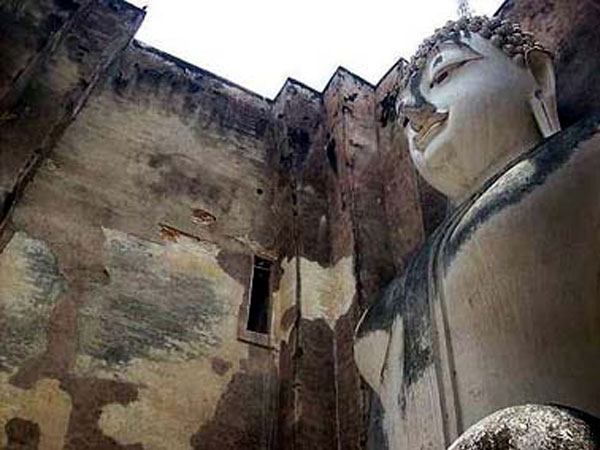Nicknamed the Land of Smiles, Thailand grew from a kingdom called Sukhothai, which means Dawn of Happiness. Today, the kingdom consists of a sleepy town called New Sukhothai and some sprawling ruins.
Unlike other history-soaked haunts, Sukhothai has a light touch, a rosy glow and some magic reflected by the exquisitely carved Buddha smiles on the faces of statues gracing its ruins.
Peppered with lakes and lawns, Sukhothai is undeniably beautiful. Would-be admirers should know that from Bangkok, the 450-kilometer journey north to the town that straddles the Yom River takes about six hours, so you might want to take an 80-minute flight instead.
The destination, which dates back eight centuries, was put on the map by “the father of Thailand”: the kind and canny King Ramkhamhaeng. Credited with creating the Thai alphabet and a golden post-Khmer age, Ramkhamhaeng made Sukhothai the first independent Thai state and the cradle of Siamese civilization.
Sukhothai’s dominance lasted for over a century when it was ousted by rival Thai kingdom, Ayutthaya. The remains of heyday Sukhothai are mostly scattered around the 70 square kilometer heritage-listed Historical Park set 12 kilometers– or “kilos” as Thais say – from town along the Sukhothai-Tak Highway.
When I roll up at the park in a rattletrap tuk-tuk taxi, my Thai lady travel buddy, who normally motorbikes everywhere, says she cannot face walking around in the heat. She would rather, she announces, be by the sea at the royal resort of Hua Hin. So, while she sulks in the tuk-tuk, chatting to the mustached, twinkly driver, I broach the park’s baking heat alone and snap away, without having to queue anywhere or nod to more than one other gawker.
The guesthouse that I had just escaped from may be brimming with backpackers; still, aside from a sprinkling of Thai officials, the ruins here border on deserted but have a bit of everything: ruined palaces, temples, city gates, dams, canals, even the remains of a dyke control system said to be the kingdom’s spiritual center.
Only structures built in stone retain a strong claw-hold. The park’s obvious heart is the moat-ringed, pillar-infested Wat Mahathat (“Great Relic”): one of Thailand’s oldest and most important Buddhist temples with two huge Buddhas at its entrance. Inside the rambling open-air complex, the main lotus bud-shaped chedi burial structure houses Buddha relics, experts believe.
According to the website Thailand’s World, of the eight smaller surrounding chedi, the four brick ones at cardinal points reflect the Khmer style, while the four on the sides indicate the art of the local tribe, Lanna. The intricate symbolism suggests that Wat Mahathat was vital to Sukhothai culture.
Either way, it radiates atmosphere worthy of a mystery cult, which is capitalized on ritualistically every year. During the picturesque full moon festival, Loy Kratong, it serves as the stage for a light-and-sound spectacle.
South of the temple’s complex presence stands Sukhothai’s oldest structure, Wat Si Sawai. Odd like an architectural folly designed to surprise, Wat Si Sawai consists of triple corncob-shaped towers, or prang. Centuries before the Sukhothai kingdom that’s vastly bigger than modern Thailand arose, Wat Sri Sawai was designed as a Hindu shrine, historians think.
On-site discoveries – including a carved lintel depicting the top Hindu god Vishnu and linga (don’t ask) – fuel the theory that Wat Si Sawai is a “lost Khmer temple”.
In light of Wat Si Sawai and other attractions, my guidebook’s claim that Sukhothai “is not particularly interesting” strikes me as harsh. The highlight of the crazy quilt Historical Park may well be the mysterious mega-Buddha housed well north of Wat Mahathat at Wat Si Chum (Temple of the Bodhi Tree).
The 11-meter tall brick-and-stucco seated monster stares at visitors through the slit in its custom-built cuboid mondop. Squeeze into the bodhi tree Buddha’s space, and you will notice its elegantly tapered fingers finessed with gold-leaf nail varnish.
According to legend, the inanimate Buddha with a ladyboy look could talk to worshippers. The hidden staircase that runs up into its head might have let tricksters create that illusion. One Sukhothai king apparently did, hiding in the enlightened one’s head and giving his troops a pre-battle talk meant to drive them to victory.
The idol with the svelte looks mirrored by other Sukhothai Buddhas must have seemed an odd source of fighting tips. It might have had more to say on grooming. Anyway, it remains one of Sukhothai’s most bewitching sights amid stiff competition.
On the kingdom’s fringes, at the end of a zigzagging path, the giant Buddha of Wat Saphan Hin (Stone Bridge Monastery) stands atop a hill, commanding fine views and attention. Farther in towards town, across a lake, a gold-leaf “Buddha footprint” shines, kept in a shrine.
Then there is Wat Chang Lom (“Temple Surrounded by Elephants”), which features a bell-shaped chedi adorned with – you guessed it – elephant sculptures.
Even if Sukhothai lacks the chic pizzazz of Hua Hin, it oozes intrigue. If you want a taste of it, rather than riding out on a tuk-tuk in the stinging sun, go by bike at 7am when the park is just opening, and you can smell the lilies. Ideally, bring a guide because, despite Sukhothai’s heritage status, signage is minimal.
A stroll of the kingdom with the name that breathes happiness can feel like a mystery tour.


